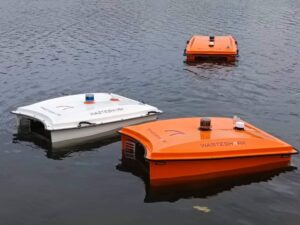
IntroductionWater pollution is a pressing global issue that threatens ecosystems and human health. As pollution levels continue to rise, innovative technologies are being developed to combat this problem. One such technology is the RanMarine WasteShark, an aquatic drone designed to remove floating debris from waterways.
How the WasteShark OperatesThe WasteShark aquadrone, developed by RanMarine Technology, operates akin to a water-based Roomba vacuum cleaner. With a capture basket capacity of 42 gallons, this coffee table-sized robotic drone demonstrates its remarkable capabilities by efficiently collecting and removing up to 1100 pounds of waste on a daily basis from diverse aquatic environments such as harbors, marinas, estuaries, and lakes. It excels in accessing small, hard-to-reach areas, ensuring that debris is effectively tackled in critical chokeholds. Whether operated manually through remote control or autonomously following a pre-programmed route using an online dashboard, the WasteShark’s adaptability guarantees highly effective and efficient cleaning operations.
Types of Debris RemovedThe WasteShark is designed to combat various types of debris polluting our waterways. It targets floating debris or trash and even small plastic pollution, which poses a significant threat to marine life and water quality. Additionally, the WasteShark can remove unwanted biomass vegetation from the water surface. Harmful algal blooms release toxins that contaminate drinking water, causing illnesses for animals and humans.
Global ImpactThe global impact of water pollution around the world can be greatly addressed by solutions like the WasteShark. Researchers estimate that 10,000 metric tonnes of waste enter the Great Lakes alone each year, with a significant portion being plastic. By efficiently removing this waste, WasteShark helps mitigate the harmful effects of anthropogenic debris on wildlife, drinking water, and public enjoyment of water resources. Its contribution to cleaner waterways positively impacts ecosystems and human well-being on a global scale.
Organizations Utilizing the WasteSharkOne notable organization utilizing the WasteShark is PortsToronto. In partnership with RanMarine Technology, PortsToronto has launched a pilot program that introduced two WasteShark aquadrones, named Ebb and Flow, to the Toronto Harbour. As part of PortsToronto’s Trash Trapping Program, Ebb and Flow join the network of Seabins deployed to capture floating debris and small plastic pollution. This program is supported by a grant initiative from the Ministry of Foreign Affairs of the Netherlands, aligning with the United Nations’ Sustainable Development Goals.
PortsToronto’s Trash Trapping Program, in collaboration with the University of Toronto Trash Team and the International Trash Trap Network, recognizes the invaluable contribution of the WasteShark aquadrones in collecting vital data on the type, amount, and sources of debris in the Toronto Harbour and Lake Ontario. By utilizing the WasteSharks, PortsToronto can significantly enhance its trash-trapping capabilities and expand research efforts to gain a deeper understanding of plastic pollution and its effective mitigation strategies.
ConclusionThe RanMarine WasteShark represents an innovative solution for combating water pollution and the accumulation of debris in aquatic environments. Its ability to collect floating debris, small plastic pollution, and biomass has a significant global impact by improving water quality, preserving ecosystems, and safeguarding public health. Through the efforts of organizations such as PortsToronto, WasteShark contributes to data collection, research, and collaboration necessary to address water pollution on a larger scale. As the demand for sustainable and efficient cleaning technologies continues to grow, WasteShark offers hope in creating cleaner waterways worldwide.